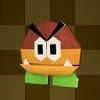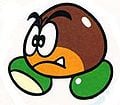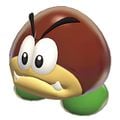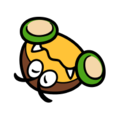Galoomba: Difference between revisions
m (Text replacement - "(\| *publisher *= *Nintendo[^\n}]*)(\| *author *= *Nintendo)([\|}])" to "$1$3") |
SuperBallBro (talk | contribs) (Goombas added as relative) |
||
| Line 5: | Line 5: | ||
|latest_appearance=''[[Tetris 99]]'' (27th Maximus Cup, cameo) (2021) | |latest_appearance=''[[Tetris 99]]'' (27th Maximus Cup, cameo) (2021) | ||
|variants=[[Big Galoomba]]<br>[[Paragaloomba]]<br>[[Goombud]]<br>[[Parachute Galoomba]]<br>[[Para-Goomba (Mario Clash)|Para-Goomba (''Mario Clash'')]] | |variants=[[Big Galoomba]]<br>[[Paragaloomba]]<br>[[Goombud]]<br>[[Parachute Galoomba]]<br>[[Para-Goomba (Mario Clash)|Para-Goomba (''Mario Clash'')]] | ||
|relatives=[[Goomba]] | |||
|derived_subjects=[[Wanderin' Goom]] | |derived_subjects=[[Wanderin' Goom]] | ||
|comparable=[[Gamboo]] | |comparable=[[Gamboo]] | ||
|notable=[[Goombob]]<br>[[Goombetty]] | |notable=[[Goombob]]<br>[[Goombetty]] | ||
}} | }} | ||
'''Galoombas''' (named '''[[Goomba]]s'''<ref name=SMW>{{cite|title=''Super Mario World'' instruction booklet|page=23|date=1991|publisher=Nintendo of America|language=en-us}}</ref> before ''[[Super Mario 3D World]]'') are | '''Galoombas''' (named '''[[Goomba]]s'''<ref name=SMW>{{cite|title=''Super Mario World'' instruction booklet|page=23|date=1991|publisher=Nintendo of America|language=en-us}}</ref> before ''[[Super Mario 3D World]]'') are relatives of [[Goomba|Goombas]] that first appear in ''[[Super Mario World]]''. They either walk across the ground, parachute from above or float down in bubbles (which burst upon coming into contact with any object), or can even appear with wings to hop around. | ||
In Japanese, these enemies have always been referred to as ''Kuribon'', marking them as a distinct species from Goombas, which are called ''Kuribō''. In other languages, however, they were treated as interchangeable and did not have a distinct name until ''Super Mario 3D World''. | In Japanese, these enemies have always been referred to as ''Kuribon'', marking them as a distinct species from Goombas, which are called ''Kuribō''. In other languages, however, they were treated as interchangeable and did not have a distinct name until ''Super Mario 3D World''. | ||
Revision as of 13:44, August 6, 2024
| Galoomba | |||
|---|---|---|---|
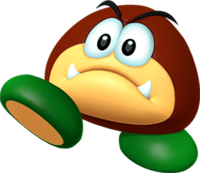 Artwork of a Galoomba from Mario Party 10. | |||
| First appearance | Super Mario World (1990) | ||
| Latest appearance | Tetris 99 (27th Maximus Cup, cameo) (2021) | ||
| |||
| |||
| |||
| |||
| |||
Galoombas (named Goombas[1] before Super Mario 3D World) are relatives of Goombas that first appear in Super Mario World. They either walk across the ground, parachute from above or float down in bubbles (which burst upon coming into contact with any object), or can even appear with wings to hop around.
In Japanese, these enemies have always been referred to as Kuribon, marking them as a distinct species from Goombas, which are called Kuribō. In other languages, however, they were treated as interchangeable and did not have a distinct name until Super Mario 3D World.
History
Super Mario series
Super Mario World / Super Mario World: Super Mario Advance 2
This variation of Goomba debuts in Super Mario World, first appearing in Donut Plains 4. Although these creatures walk in straight paths to attack like regular Goombas, they do not resemble the original ones. These Goombas do not have mushroom-shaped heads but rather more spherical ones. They also lack a stem; the Goomba's two feet are attached directly to the bottom of the head. As such, they resemble chestnuts more than mushrooms. Here, they have yellow feet.
They cannot be defeated in a single jump, as doing so flips them over and immobilizes them. In this state, they can be picked up and thrown at other enemies, like with Koopa Troopas. Running into them or jumping on them when flipped causes them to be kicked around (though they do not ricochet, like shells do). After a few seconds they right themselves, which damages Mario if he is carrying one. They can automatically be defeated with a Spin Jump, with a fireball or an attack from Yoshi; an attack with the cape causes them to be flipped over as well.
These Goombas face the side as opposed to the camera like the original Goombas, though this trait would be later given to them in 2D games starting from New Super Mario Bros.
There are two variants of Goombas in the original Super Mario World. Para-Goombas are Goombas which utilize parachutes instead of being Goombas with wings, though Flying Goombas, which are wing-bearing Goombas, also appear, and can only hop on the ground instead of fly. Like Paragoombas, Flying Goombas' wings are clipped after one stomp, reverting them to normal Goombas, and thus, stomping on them after their wings are gone just renders them helpless for a few moments, allowing the player to throw them at other enemies. Spiked versions of Flying Goombas also known as Para-Goombas later appeared in Mario Clash.
In the Game Boy Advance remake, Super Mario World: Super Mario Advance 2, after the player beats the Special Zone and finds all of the exits, the Goombas are recolored yellow and wear sunglasses.
Super Mario Advance 4: Super Mario Bros. 3
In Super Mario Advance 4: Super Mario Bros. 3, a single Super Mario World Goomba appears at the end of the World-e level Rich with Ropes, where Para-Goombas can also be found. They can be stomped on and grabbed like in Super Mario World.
Super Mario 3D World / Super Mario 3D World + Bowser's Fury
After a long absence, Galoombas reappear in Super Mario 3D World and its Nintendo Switch port under their current name, alongside regular Goombas and a bigger variation named Big Galoomba. Like normal Goombas in 3D Super Mario games, they attempt to chase after the player upon seeing them. Additionally, like in Super Mario World, Galoombas cannot be defeated with one jump, as that causes them to be flipped over, though unlike in Super Mario World, a second jump defeats them. A Ground Pound can also be used to defeat them in one hit. Additionally, Galoombas cannot be carried, kicked around, or thrown, as running into them while immobilized also causes them to be defeated.
Super Mario Maker / Super Mario Maker for Nintendo 3DS
Galoombas replace regular Goombas when in the Super Mario World style in Super Mario Maker and Super Mario Maker for Nintendo 3DS. They use a slightly edited version of their original sprite from Super Mario World; their feet are colored green instead of yellow to match their artwork and modern appearances. When stomped on, they turn upside down, waiting for the player to pick their bodies up and hurl them. If a Super Mushroom is dragged onto a Galoomba, the enemy will transform into a Big Galoomba; if wings are given to a Galoomba, it will become a Paragaloomba.
Super Mario Maker 2
Galoombas reappear in Super Mario Maker 2. In addition to retaining their previous properties, by tapping and holding Galoombas in Course Maker, they can be changed into a Goombrat-like enemy called Goombud. Although Galoombas coexisted with Goombas in Super Mario 3D World, which has its own style in this game, they remain exclusive to the Super Mario World style.
Mario's FUNdamentals
Galoombas, in their Super Mario World design, appear on one of the cards in Go Fish.
Super Mario World cartoon
These Goombas appear twice in the Super Mario World cartoon. They first appear in "The Wheel Thing", in which they are shown as being the "power source" for the cars made by Mario and Luigi. They also briefly appear in "The Yoshi Shuffle" in the audience during the football game.
Super Mario Adventures
In Super Mario Adventures, these Goombas and at least two Flying Goombas were sent by Bowser to attack Princess Toadstool's Palace. In addition, they were among the attendees to Bowser's marriage to the hypnotized Princess Toadstool.
Mario Party series
Mario Party 3
While normal versions of these Goombas themselves are not in the game, Flying Goombas appear as an obstacle during the minigame Ridiculous Relay. The single player must dodge both them and Banzai Bills in their hand glider, and reach the finish line before the other three players do.
Mario Party Advance
In Mario Party Advance, due to appearing alongside standard Goombas, this version of Goomba is relocalized in English as "Goombob", a character who lives at Goombob Manor. Another member of the species that appears is his crush, Goombetty. Red and blue versions of this type of Goomba also appear in Tap-Tap Sumo.
Mario Party 10
Galoombas appear in Mario Party 10, appearing in a few minigames that also feature Goombas and Goombrats.
Mario Party: Star Rush
Galoombas appear in the Mario Party: Star Rush minigame Goomba Guess. The goal of the minigame is to tap the most Goombas, while Galoombas deduct one point from the player. In the beginning of the minigame, the placement of the enemies are shown before they shift positions, and afterward are covered by a dark veil so players are required to memorize the placements beforehand.
Super Mario Party
Galoombas appear in Super Mario Party as non-playable characters. They can be seen in the minigames Nut Cases and Take a Stab.
Mario Party Superstars
Three Galoombas appear in Mario Party Superstars in the background of Woody Woods, replacing the Wigglers from the Mario Party 3 version. Two of them are talking to each other, while the other can be seen juggling an apple. In their encyclopedia entry, it is mentioned that they are often confused with Goombas.
Paper Mario: The Origami King
Galoombas make their Paper Mario debut in Paper Mario: The Origami King, where origami Galoombas make an appearance as enemies. Galoombas first appear in Chestnut Valley, in which a group of them will ambush Mario if he hits a tree that a Goomba climbs. Later, several Galoombas will ambush Mario from rolling chestnuts, and some will attempt to block his path with a chestnut.
In Shogun Studios, a group of Galoombas ambush Mario from one of the sand patches in a house.
In battle, Galoombas attack Mario with a Headbalonk move. If they have HP remaining after jumping on them, they will flip over like in the mainstream Super Mario series.
Dr. Mario World
Galoombas appear in Dr. Mario World as assistants. In stage mode, they grant a chance that two objects, mainly viruses, transform into pop cannons at the start of a stage. In versus mode, their effect is to transform two of the viruses that appear after all viruses are eliminated into pop cannons. In both cases, the chances that the effects occur are greater at higher levels. They also appear on the World 21 map after an area has been cleared of viruses. A Galoomba assistant is rewarded after clearing the first area in World 21.
Profiles and statistics
Super Mario World / Super Mario World: Super Mario Advance 2
- Super Mario World Instruction Booklet: "Jump on it to make it roll. You can also hold it or throw it."[1]
- Super Mario World: Super Mario Advance 2 "Denizens of Dinosaur Land" poster: "Stomp Goombas once to flip them over, then pick them up and toss them."
Perfect Ban Mario Character Daijiten
Mario Party: Star Rush
| Image | Name | Bio |
|---|---|---|

|
Galoomba A Goomba-like foe that is not a Goomba. |
"I know they're similar, but for their sake, do try keeping your Galoombas and Goombas straight!" |
Paper Mario: The Origami King
| Paper Mario: The Origami King enemy | |||||||||||||||
|---|---|---|---|---|---|---|---|---|---|---|---|---|---|---|---|
| Galoomba | |||||||||||||||

|
HP | 11 | Moves | Location(s) | |||||||||||
| Type | Normal | Headbalonk (5), Group Headbalonk (base 4 per Galoomba, range starts at 0 and increases by 1 for each additional Goomba), Wave Headbalonk (base 4 per Galoomba, range starts at 0 and increases by 1 for each additional Goomba, multiple hits), Tower Attack (base 5 for one, 10 for two, 14 for three, 17 for four, 19 for five, increases by one for any extra after five; range is 0 for one or two, 1 for three, 3 for four, 6 for five, increases by four for any extra after five) | Chestnut Valley, Shogun Studios | ||||||||||||
| Role | Common | ||||||||||||||
| Item drops | Mushroom | ||||||||||||||
|
|
They make their homes near chestnut trees. A good stomping will make them topple over, so have at it. | ||||||||||||||
Dr. Mario World
- Stage mode: "Grants 15%/30%/45%/60%/80% chance pop cannons (2) will appear on stage start."
- Versus mode: "If all viruses in your stage are eliminated, grants 15%/30%/45%/60%/80% chance pop cannons (2) will appear."
Mario Party Superstars
- Encyclopedia bio: "Bowser's minions. Often mistaken for Goombas."
Gallery
- For this subject's image gallery, see Gallery:Galoomba.
Names in other languages
| Language | Name | Meaning | Notes |
|---|---|---|---|
| Japanese | クリボン[?] Kuribon |
Portmanteau of「クリボー」(Kuribō, "Goomba") and「坊」(bon, an affectionate term for boys); this is also the name for Goombob from Mario Party Advance | |
| Chinese | 栗邦邦[?] Lì Bāngbāng |
From「栗寶寶」(Lì Bǎobǎo, "Goomba") and「硬邦邦」(Yìng Bāngbāng, "tough") | |
| Dutch | Galoomba[?] | - | |
| French | Galoomba[?] | - | |
| German | Galumba[?] | Transliteration of the English name | |
| Italian | Goombruno[?] | Pun on "Goomba" and "Bruno" ("dark brown", also an Italian common name). Goombruno is also the name Goombob had in Mario Party Advance | |
| Korean | 밤바[?] Bamba |
Portmanteau of "밤" (bam, "chestnut") and "Goomba" | |
| Portuguese (NOA) | Goombola[?] | Pun on "Goomba" and bola ("ball") | |
| Portuguese (NOE) | Galoomba[?] | - | |
| Romanian | Goomba (Super Mario World animated series)[?] | Goomba | |
| Russian | Галумба[?] Galumba |
Galoomba | |
| Spanish | Goombaya[?] | Pun on "Goomba" and baya ("berry") |
Trivia
- In Super Smash Bros. for Wii U, while Galoombas do not appear directly in the game, they are mentioned in one of the randomly generated Tips. In the tip, it is clarified that Super Mario World has no Goombas, and that Galoombas are a different species.
References
- Galoombas
- Dr. Mario World
- LEGO Super Mario characters
- Mario Party 10
- Mario Party Advance species
- Mario Party: Star Rush
- Paper Mario: The Origami King enemies
- Super Mario Advance 4: Super Mario Bros. 3 enemies
- Super Mario 3D World enemies
- Super Mario Maker enemies
- Super Mario Maker 2 enemies
- Super Mario World enemies
- Super Mario World (television series)


